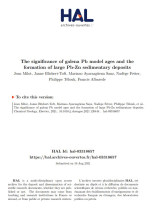Добрый день, Коллеги. Важное сообщение, просьба принять участие. Музей Ферсмана ищет помощь для реставрационных работ в помещении. Подробности по ссылке
The significance of galena Pb model ages and the formation of large Pb-Zn sedimentary deposits / Значение возраста Pb-модели галенита для формирования крупных осадочных отложений Pb-Zn
In an attempt to clarify the significance of Pb model ages in Pb-Zn sedimentary deposits, we report high-precision Pb isotopic compositions for 64 galenas and 52 K-feldspars, the former from ores and the latter separated from granites. All samples are from Spain and the French Pyrenees. Lead from galena ores is of unequivocal continental origin. With few exceptions, Pb model ages systematically exceed emplacement ages by up to 400 Ma, a gap which is well outside the uncertainties of ~30 Ma assigned to the model. The histo20 gram of the new high-precision Pb isotope data shows prominent peaks of galena Pb model ages at 94±38 Ma and 392±39 Ma. When the data are consolidated with literature data and examined in 3-dimensional Pb isotope space, cluster analysis identifies five groups. The model ages of the peaks occur, in order of decreasing peak intensity, at 395±40 (Middle Devonian), 90±34 Ma (Middle Cretaceous), and 613±42 Ma (Neoprotero25 zoic), with two minor peaks at 185+26 Ma (Jurassic) and 313±41 (Upper Carboniferous). To a large extent, the model ages centered around these peaks correspond to distinct lo27 calities. The ages of the peaks do not coincide with any of the Betic, Variscan, or Pan28 African tectonic events, which are the main tectonic episodes that shaped Iberian geology, but rather match well-known global oceanic anoxic events. It is argued that surges of metals weathered from continental surfaces scorched during anoxic events accumulated and combined in anoxic water masses with unoxidized marine sulfide released by subma32 rine hydrothermal activity to precipitate the primary Pb-Zn stock. <...>




